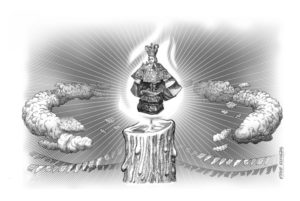 Though visited by overcast skies or rain, this year’s Fiesta Señor was successful and showed noticeable improvement on many fronts.
Though visited by overcast skies or rain, this year’s Fiesta Señor was successful and showed noticeable improvement on many fronts.
Extensive social media use by Basilica Minore del Santo Niño staffers helped ensure that most church-going devotees knew the disembarking and boarding points for vehicles, as well as the entry and exit points for foot traffic.
Repeat reminders by lay ministers that “cleanliness is next to godliness” visibly affected the environment in and around the Basilica. The area remained relatively trash-free in the 10 days leading to the fiesta.
Placards with messages that forbade worshipers to use cameras during Holy Mass helped preserve the solemnity of the Eucharistic celebrations.
Announcement of closing times to clean up the Basilica complex erased tensions between guards or volunteers and pilgrims who assumed that the Basilica was continually accessible for 24 hours during the novenario and fiesta.
Requests for devotees to refrain from arguing with security personnel who closed the gates whenever the complex was full helped, too.
Clear instructions about the arrangement of clergy, religious, seminarians and laity in the pilgrim center during the hour-long prayer dance in honor of the Holy Child on fiesta eve ensured that incidents as in previous years of excited devotees breaking into the sanctuary did not recur.
Absence of fireworks during the dance enhanced its solemnity. The faithful focused on offering prayers without sporadically breaking into cheers and roars in awe of pyrotechnics.
Strategic use of communication plus other efforts to secure Fiesta Señor and keep it orderly earn for organizers and their supporters well-deserved congratulations and gratitude from the public.
That is not to say there is no room for improvement in future annual celebrations. This year’s foot procession was delayed for the good part of an hour on a stretch of Osmeña Boulevard where student volunteers were absent from crowd control duty and spectators drew close to the Santo Niño’s carriage.
Incidents like this can be prevented with stronger commitment to fulfill assignments among future crowd control volunteers.
Entry of devotees to the pilgrim center especially for novena Masses at 5:30 p.m. and 7 p.m. can be eased. Public pleas for restraint could only go so far, as ingress currents led to pushing and shoving among persons standing body to body as they moved in.
Can the second gate behind the pilgrim center sanctuary be used as a third entry point on Burgos Street? A gate behind Colegio del Santo Niño can also be a second entrance on Jakosalem Street.
Since streets around the Basilica complex become church extensions during the festive season, church, government and civic organizations should clearly reserve spaces for those who participate in the Masses on these streets to separate them and from those who have to go in or out of the pilgrim center.
It would also help if Lapu-Lapu and Magallanes Streets are cleared of vendors who, along with their customers, end up impeding the flow of foot traffic to and from the Basilica.
As long as buildings surround the Basilica (donations of the plots of land on which they stand is wishful thought for now), organizers should continually be on the lookout to improve the ergonomics of pilgrimage to Cebu’s Holy Child.
Disclaimer: The comments uploaded on this site do not necessarily represent or reflect the views of management and owner of Cebudailynews. We reserve the right to exclude comments that we deem to be inconsistent with our editorial standards.
